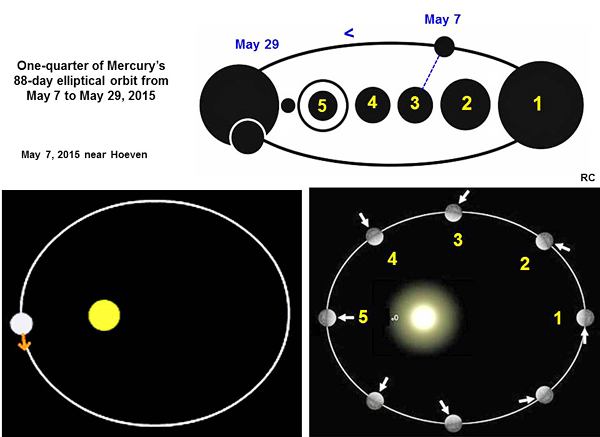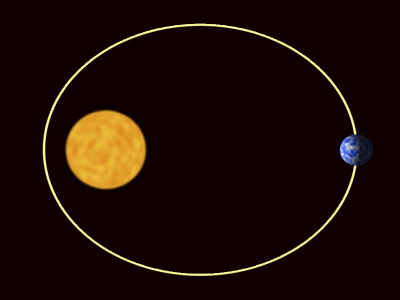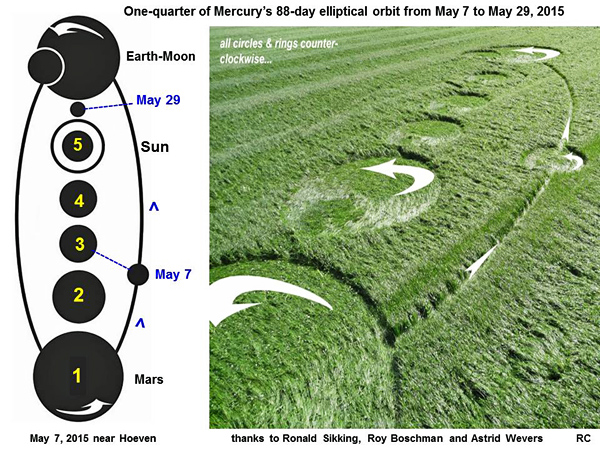The
grass picture near Hoeven on May 7, 2015 seems to show an elliptical
orbit for planet Mercury: starting on May 7 when that field picture
appeared, then ending on May 29 when Mercury will reach inferior
conjunction with our Sun (as seen from Earth)
Our path
to understanding this new field image was as follows: first, the
orbit of Mercury is an “ellipse”, while this new grass picture from
May 7 shows an “orbital ellipse” for some unspecified planet. It has
been combined there with other circular symbols of a complex nature,
to be explored further below.
An
elliptical orbit for Mercury, which may be divided into eight
smaller parts
When we
compare a standard orbital diagram for Mercury, with a
black-and-white diagram of this new grass picture, we find a good
match to first approximation:

The
elliptical orbit of Mercury about our Sun requires 88 days. It is
often divided into eight parts of 11 days each. This grass picture,
even on first glance, seems to resemble parts “1” to “5” of
Mercury’s orbit around our Sun.
Furthermore, a small circle has been drawn along its outer
“elliptical orbit” near location “3”. This matches where Mercury was
located in space on May 7. That was the day when this grass picture
appeared!
Mercury
continues next in its orbit to location “5”, where it will be
located between our Earth and the Sun on May 29, just 22 days later.
In astronomical terms, the May 29 alignment of Earth-Mercury-Sun is
called an “inferior conjunction”.
This
movie shows how Mercury moves in an elliptical orbit around our Sun:

It looks
like a pretty good match to me! One subtle difference between the
grass picture, and this simplified movie, would be that Mercury will
lie far from the Sun (at aphelion) on May 29, rather than close to
the Sun (at perihelion) as drawn in grass. Yet perhaps the unknown
artist is taking “artistic license”?
Mercury
reached its greatest elongation from the Sun on May 6 as seen from
Earth. Next it will reach inferior conjunction on May 30, almost
covering the face of the Sun as seen from Earth. Then Mercury will
reach aphelion from the Sun on June 3 (see
www.astropixels.com or
in-the-sky.org).
It would
not possible, by the normal rules of physics, for this grass picture
to represent a “binary star system with planets”. In such a case,
those “planets” would have to orbit outside of the two binary stars
themselves, rather than between two large end-circles (“stars”) as
shown in the field diagram (see
Circumbinary planet or
www.cfa.harvard.edu).
A
superposition of two astronomical diagrams: one shows the elliptical
orbit of Mercury, while the other shows our inner solar system
Now let
us concern ourselves with interpreting this new grass picture in
closer detail. When we examine real planetary configurations for
Mercury, Venus, Earth and Mars on May 7 (or May 29), we find that
the orbital path of planet Mercury has been well described by the
field image as shown below:

Looking
carefully at the slide above, we can see where two small blue
circles mark the relative location of Mercury on May 7, 2015 in
grass versus in space (left or right in its upper part). Two other
blue circles mark the relative location of Mercury on May 29, 2015
in grass versus in space (left or right in its lower part).
In
addition, we can see how a simple diagram for the orbit of Mercury
(as an ellipse) has been superimposed on a diagram of
our inner solar system, which includes Earth, Mars, Venus and Sun.
Two large end-circles from that grass picture seem to match the
orbital locations of Earth-Moon or Mars on May 29, 2015.
Our Sun
has been represented inside of Mercury’s ellipse near location “5”
as “one circle drawn around another circle”. That is how we will see
planet Mercury on May 29 at inferior conjunction, as superimposed
(almost) on the face of the Sun as seen from Earth. Planet Mars will
line up precisely on the opposite side of our Sun, as seen from
Earth, on June 14, 2015 a few weeks later.
Details
of the flattened lay agree well with this model
Studying
next certain details of the flattened lay, we can see how an
anti-clockwise sense of the lay matches an anti-clockwise sense of
orbital motions around our Sun for all four inner planets, as viewed
from this perspective:

Likewise, an anti-clockwise sense of the lay within a small outer
circle for “Mercury” on May 7 matches the slow rotational motion of
that planet as it orbits our Sun. Please examine light-dark shadings
of Mercury in the first slide above.
The only
serious distortions of this field image, away from a literal drawing
of our inner solar system, would be: (1) the relatively small size
of our “Sun”, relative to large sizes for “Earth” and “Mars” on each
end; plus (2) an aphelion versus perihelion location for “Mercury”
as noted above. Once again, the crop artist may be trying to get
across a specific message, rather than trying to draw a precisely
accurate model of our solar system. The entire field diagram seems
to focus on planet Mercury and its elliptical orbit around our Sun
from May 7 to May 29, rather on the Sun or other planets. Venus
seems not to be described at all.
Mars on
May 29, 2015 will lie opposite Earth, and four orbital paths out
from the Sun
Finally
we can see, in the slide below, how all four planets and Earth’s
Moon will appear on May 29, when Mercury reaches inferior
conjunction. There may be a second way of numbering those four inner
circles from the field diagram as “1-2-3-4”, in order to suggest
that a large end-circle near the top represents “planet Mars”, which
is fourth out from the Sun:

How can
we be sure which inferior conjunction of Mercury was
described in grass on May 7 near Hoeven? Mercury moves between Earth
and our Sun three times per year, with a synodic period of 116 days,
versus only 88 days for its orbit around the Sun. When we studied
the next four inferior conjunctions of Mercury, which will occur in
years 2015 or 2016, we learned that only the conjunction of May 29,
2015 shows another planet which opposes Earth and Moon, at four
orbits away from the Sun.
Thus on
May 30, 2015, Mars will lie opposite Earth, and four orbits out from
the Sun. On September 30, 2015, no planet will lie opposite Earth.
Again on January 14, 2016, no planet will lie opposite Earth. Then
on May 9, 2016, Venus will lie opposite Earth, but only two orbits
out from the Sun (see
www.fourmilab.ch). A
previous grass picture on April 28 likewise shows symbols which
suggest “month 5” and “day 2-9” or a date of “May 29” (see
Oudenbosch).
Since this grass picture was drawn in the same field, it seems only
logical that it might subtly encode the same date.
What
might be so important about May 29, 2015? Do the crop artists just
“love astronomy”, or will something happen then?
Why
would those unseen “crop artists” wish to show us a coded date of
May 29, 2015? Maybe they just “love astronomy”, and like to make
clever diagrams of an astronomical kind? Alternatively, the careful
study of this grass picture and its surrounding landscape features,
as well as a nearby grass picture on April 28, 2015, suggests that
such images may possibly have been drawn by time travellers, however
improbable and outlandish that might seem to the general public
today. We have found, by studying many different crop pictures, that
they do sometimes “mark” near-future events (see for example
fringe2015c).
How can
anyone understand what time-travellers really think, or their
underlying reasons for doing something, without knowing more about
who they are, and their technical capabilities in space-time
physics? In any case, while drawing “crop pictures” (Linda Howe was
told back in 1991, that this was the theory favoured by US
intelligence agencies to explain the crop-circle phenomenon), they
must ensure that any information supplied remains fairly
cryptic. Otherwise Earth’s historical timeline could be
changed in an unpredictable fashion, if humans of our era see and
respond to such field information, then act differently than they
would have acted otherwise
Based on
what we have found, from our detailed but private studies, we
suspect that these two new grass pictures in Holland might describe
some near-future event of a geological (or oceanic) nature.
Most
people from the general public would naturally assume that both
grass pictures might have been “faked” using “rope and boards”. That
sceptical opinion might be of value in some circumstances. Yet in
the present circumstance, how can we explain so many fine details in
the lay of flattened grass, using a rope-and-boards hypothesis?(see
Hoeven)
Why use
astronomy to tell a date? Why not use normal symbols which everyone
can understand?
Why
don’t those crop artists use our modern calendar to tell a date?
Well, they did so perhaps on June 4, 2014 near Standdaarbuiten (see
Standdaarbuiten).
On that occasion, they drew five large circles to suggest “month 5”.
Their fifth circle was further “circled”, and pointed toward 27 or
29 “small bars” in the landscape above (see
comments).
Might that crop picture from 2014 suggest the same date of “5-29”
which was just described on May 7, 2015, using an astronomical
diagram? Several other “large bars” in the landscape, further above
that Standdaarbuiten crop picture, appear to show “1” and “5”,
possibly as if to suggest “1-5” or the year 2015.
Thus
those crop artists certainly do know our modern calendar, but choose
on some occasions to use astronomical diagrams to show a date,
rather than simple number symbols from our calendar. Just as another
example, the date of appearance of this new grass picture on “5-7”
(or May 7) was subtly coded into their astronomical diagram in a
clever way! Please feel free to study that result, as it has been
explained by another slide on this webpage.
Other
details of the fallen lay or nearby landscape in Holland on April 28
or May 7, 2015
Within
this new astronomical diagram, certain details of the fallen lay
within a large end-circle for “Earth” look almost like a partial
“map” of the planet. Certain “continental edges” seem to have been
drawn, close to a tall mustard plant which stands intact nearby
(please see ground photographs on
Hoeven).
The
intact mustard plant from their May 7 grass picture points in the
landscape toward a long, double-sided “ridge” below, while the
intact mustard plant from their April 28 grass picture points in the
landscape in an opposite direction, toward a “house” image just
above (see
Oudenbosch
or
comments).
These two grass pictures were laid out in nearly opposite
directions, so as to point at different but relevant landscape
features nearby. Those specific landscape features are surely a part
of their intended messages, which at present however remain somewhat
obscure.
Other
field images of “Mercury orbit” were drawn in England last summer
Two crop
pictures in England last summer, from Welsh Way on July 22, 2014
(see
Welsh Way) or
Green Street on July 29, 2014 (see
green Street),
likewise seem to suggest that some inferior conjunction of Mercury
may mark an important near-future event. Still it is hard to be sure
which inferior conjunction of Mercury those crop pictures were
referring to, or what might happen on such a near-future date? The
English crop artist was very cryptic, even more so than in Holland!
At Welsh
Way on July 22, 2014, he drew the orbital paths for three inner
planets Mercury, Venus and Earth, as they will move into the shape
of a “keyhole lock”, sometime in the near future. At Green Street on
July 29, 2014, he then informed us that the “three-digit
combination” by which to open this “lock” is “3-point-1-4” or pi!
The crop picture at Welsh Way was drawn on “pi day” July 22 or 22/7,
which approximates pi numerically. The crop picture at Welsh Way
pointed toward a huge landscape symbol nearby for the letter “pi”.
Mercury
will supposedly be close to inferior conjunction, for whichever
near-future event those two English crop pictures from 2014 might
describe. This seems just like in Holland on May 7, 2015. When and
if something important does happen, as described so cryptically by
our friends, then we will show more details.
Red
Collie
(Dr. Horace R. Drew)
P.S. We
would like to thank Robbert van den Broeke,
Ronald Sikking, Roy Boschman and Astrid Wevers for excellent field
and aerial photography.